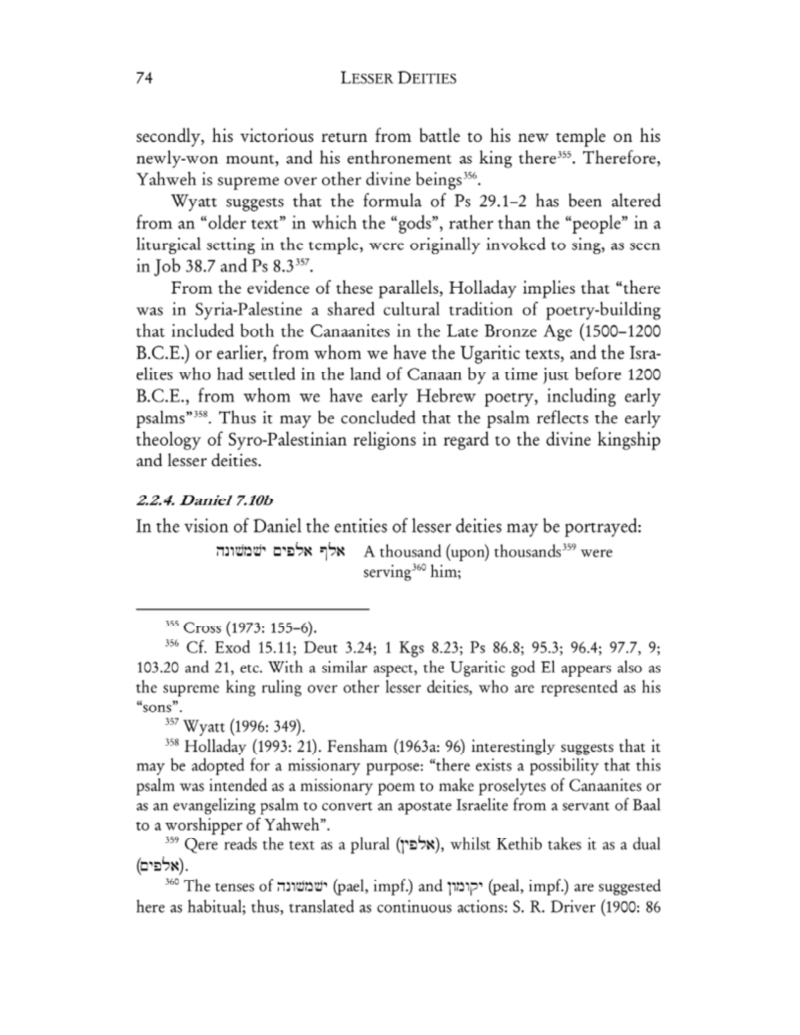Sang Youl Cho states that the members of the heavenly court in Daniel 7 are divine beings; identifies the "Ancient of Days" with "Yahweh."
- Type
- Book
- Source
- Sang Youl Cho Non-LDS
- Hearsay
- DirectSecondary
- Reference
Sang Youl Cho, Lesser Deities in the Ugaritic Texts and the Hebrew Bible: A Comparative Study of their Nature and Roles (Deities and Angels of the Ancient World 2; Piscataway, New Jersey: Gorgias Press, 2007), 74-76
- Scribe/Publisher
- Gorgias Press
- People
- Sang Youl Cho
- Audience
- Reading Public
- Transcription
Daniel 7.10b
In the vision of Daniel the entities of lesser deities may be portrayed:
אלף אלפים ישמשונה A thousand (upon) thousands were serving him
ורבו רבון קרמוהי יקמון and a myriad (upon) myriads were standing before him.
דינא יתב The court was seated.
In these Aramaic passages the members of the divine assembly are described in a poetic device; thus, the countless number of divine beings denotes a cosmic multitude of the divine assembly.
These numerous divine beings “stand” (יקומון, in v. 10b) before the “Ancient of Days” (עתיק יומין) who “sits” (יתב, in v. 9a) on “his throne” (כרסיה, in v. 9b). The Ancient of days or Yahweh is presiding over the judicial assembly. He sits on his own throne as the judge Then other divine entities are portrayed as attending the court of judgement, held by their supreme god.
Whilst the members of the divine legal “court” (דינא) “sit” (יתב, in v. 10b), other divine beings “stand” (קאמיא, in v. 16a; cf. Dan 7.16). The positions of “sitting” and “standing” explicitly as nonverbal indications, designating the rank between the higher deities and the lesser. The scene of the divine assembly is pictured very similarly to that of 1 Kgs 22.19. Thus, numberless servant deities of Yahweh in the text represent clearly the fact that they are the lesser deities of Yahweh.
- BHR Staff Commentary
Ibid., 75-76n.364 reads:
Whilst personal influence has been suggested as to the עתיק יומין, Ugaritic reference has been linked also for evidence of its origin. Eissfeldt (1965: 525) suggests that the conception of the עתיק יומין is adopted form a Syrian mythological background. Hence it has been related to the Ugaritic phrase: mlk ab šnm (KTU 1.1 iii 24; [1.2 iii 5]; [1.3 v 8]; 1.4 iv 24; [1.5 vi 2]; 1.6 I 36; 1.17 vi 49), translated as the “King, Father of years”: Porteous (1965: 107); Gibson (1978: 53). However, the phrase is best translated as the “King, Father of Bright Ones” (sc. Father of lesser deities; cf. Oldenburg, 1969: 17-8), whose meaning cultivates incongruence for a semantic comparison with the current Hebrew phrase. Further discussion of the ab šnm shall be made in Chapter II. Although the Ugaritic references are irrelevant, there are still many other possibilities in Dan 7 to admit the Ugaritic mythological influence (Emerton, 1985). Therefore, the עתיק יומין is identified, most possibly, as “Yahweh”: Zevit (1968: 392).
- Citations in Mormonr Qnas
The B. H. Roberts Foundation is not owned by, operated by, or affiliated with the Church of Jesus Christ of Latter-day Saints.

